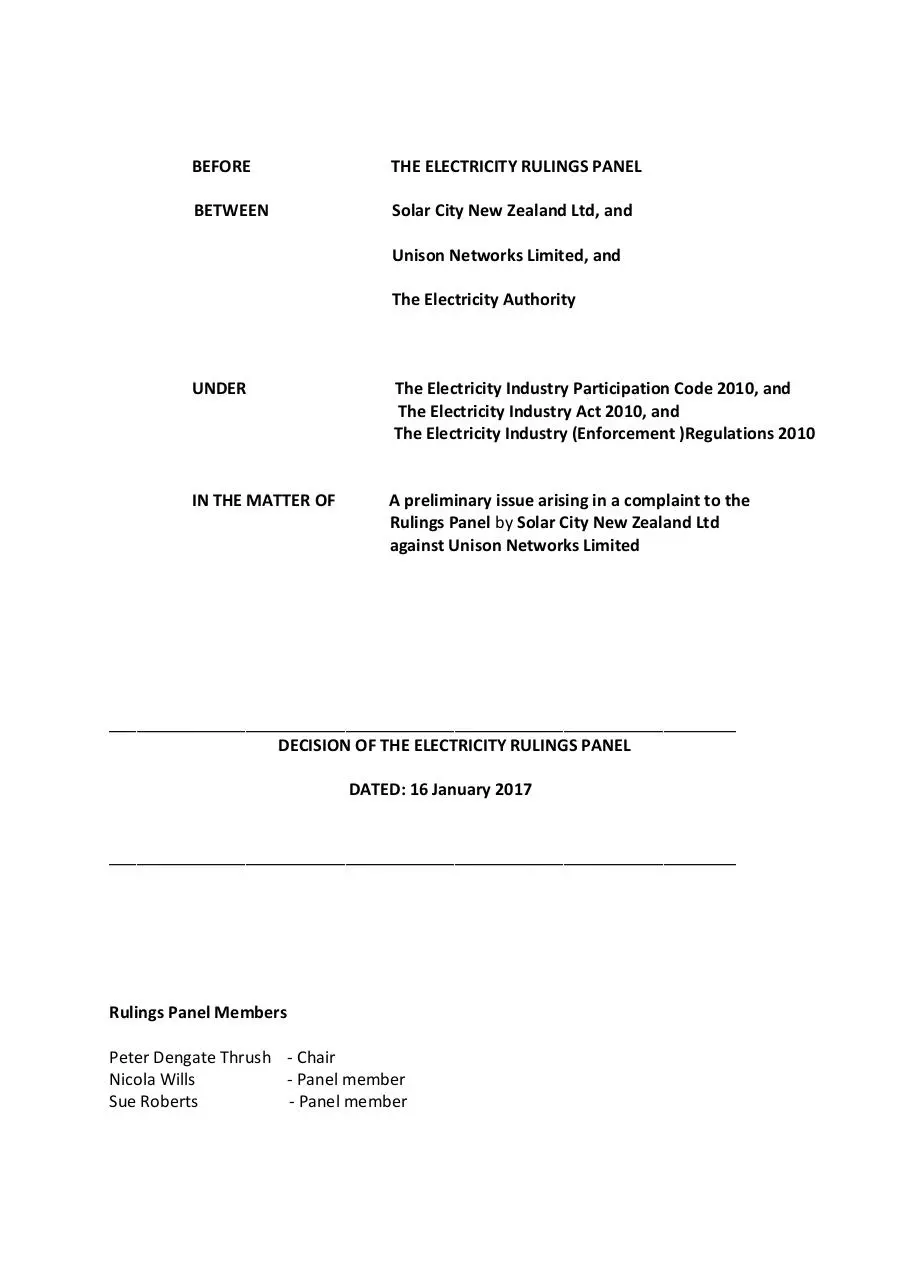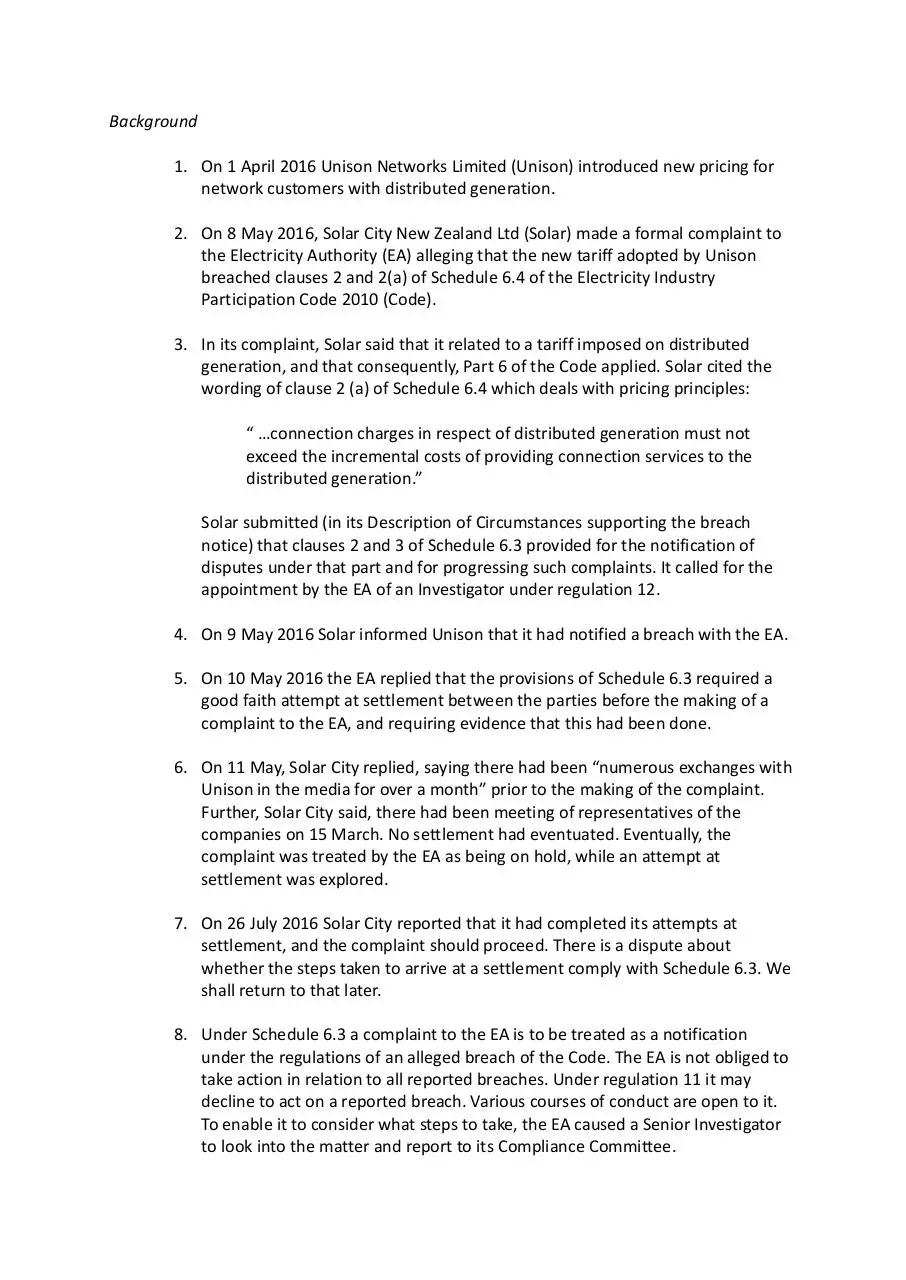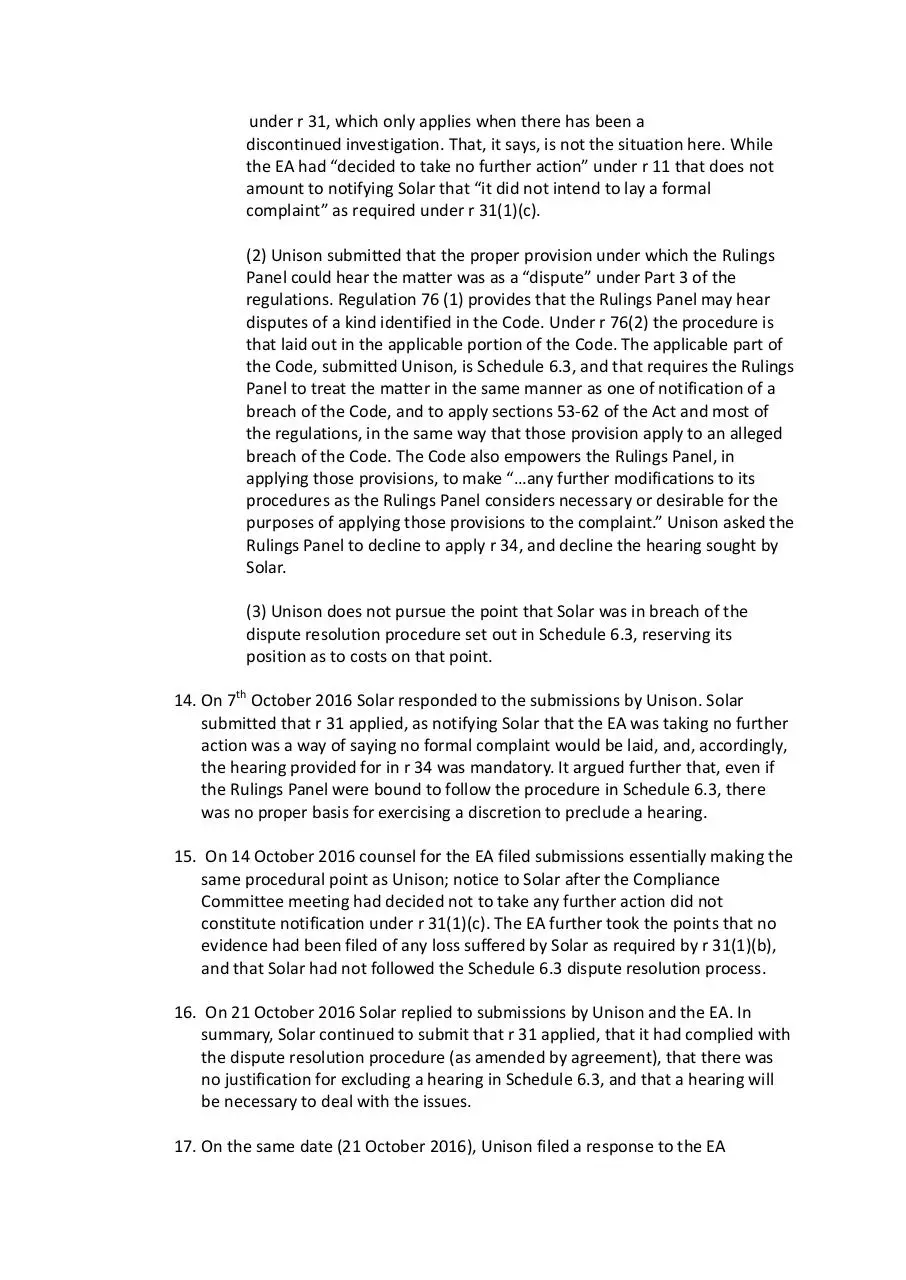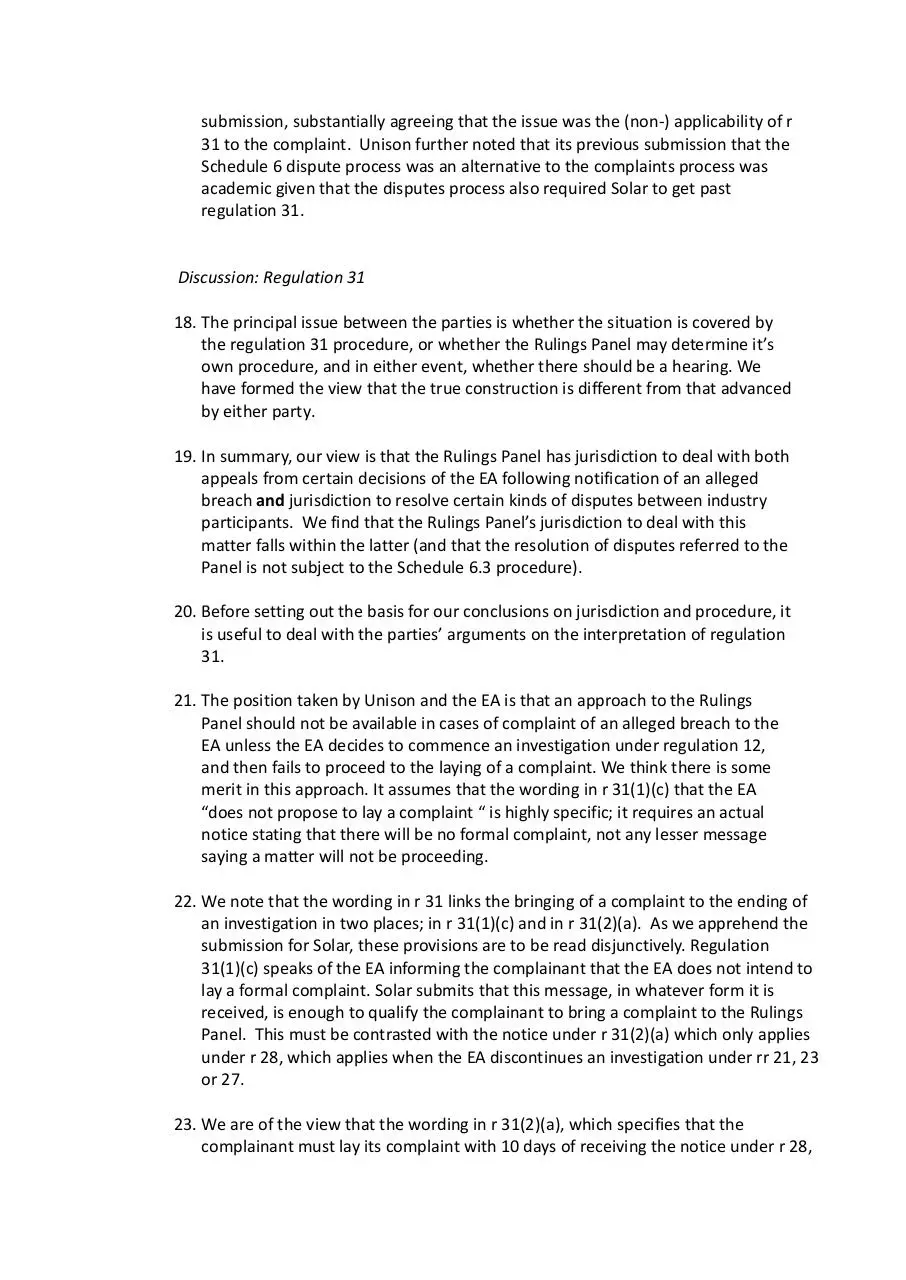Rulings Panel decision solar city (PDF)
File information
Title: Solar City 22 Dec v1.7
Author: Peter Dengate Thrush
This PDF 1.3 document has been generated by Word / Mac OS X 10.12.2 Quartz PDFContext, and has been sent on pdf-archive.com on 16/01/2017 at 10:46, from IP address 222.127.x.x.
The current document download page has been viewed 404 times.
File size: 14.78 MB (11 pages).
Privacy: public file





File preview
BEFORE THE ELECTRICITY RULINGS PANEL
BETWEEN Solar City New Zealand Ltd, and
Unison Networks Limited, and
The Electricity Authority
UNDER The Electricity Industry Participation Code 2010, and
The Electricity Industry Act 2010, and
The Electricity Industry (Enforcement )Regulations 2010
IN THE MATTER OF A preliminary issue arising in a complaint to the
Rulings Panel by Solar City New Zealand Ltd
against Unison Networks Limited
_____________________________________________________________________
DECISION OF THE ELECTRICITY RULINGS PANEL
DATED: 16 January 2017
_____________________________________________________________________
Rulings Panel Members
Peter Dengate Thrush - Chair
Nicola Wills
- Panel member
Sue Roberts - Panel member
1
Background
1. On 1 April 2016 Unison Networks Limited (Unison) introduced new pricing for
network customers with distributed generation.
2. On 8 May 2016, Solar City New Zealand Ltd (Solar) made a formal complaint to
the Electricity Authority (EA) alleging that the new tariff adopted by Unison
breached clauses 2 and 2(a) of Schedule 6.4 of the Electricity Industry
Participation Code 2010 (Code).
3. In its complaint, Solar said that it related to a tariff imposed on distributed
generation, and that consequently, Part 6 of the Code applied. Solar cited the
wording of clause 2 (a) of Schedule 6.4 which deals with pricing principles:
“ …connection charges in respect of distributed generation must not
exceed the incremental costs of providing connection services to the
distributed generation.”
Solar submitted (in its Description of Circumstances supporting the breach
notice) that clauses 2 and 3 of Schedule 6.3 provided for the notification of
disputes under that part and for progressing such complaints. It called for the
appointment by the EA of an Investigator under regulation 12.
4. On 9 May 2016 Solar informed Unison that it had notified a breach with the EA.
5. On 10 May 2016 the EA replied that the provisions of Schedule 6.3 required a
good faith attempt at settlement between the parties before the making of a
complaint to the EA, and requiring evidence that this had been done.
6. On 11 May, Solar City replied, saying there had been “numerous exchanges with
Unison in the media for over a month” prior to the making of the complaint.
Further, Solar City said, there had been meeting of representatives of the
companies on 15 March. No settlement had eventuated. Eventually, the
complaint was treated by the EA as being on hold, while an attempt at
settlement was explored.
7. On 26 July 2016 Solar City reported that it had completed its attempts at
settlement, and the complaint should proceed. There is a dispute about
whether the steps taken to arrive at a settlement comply with Schedule 6.3. We
shall return to that later.
8. Under Schedule 6.3 a complaint to the EA is to be treated as a notification
under the regulations of an alleged breach of the Code. The EA is not obliged to
take action in relation to all reported breaches. Under regulation 11 it may
decline to act on a reported breach. Various courses of conduct are open to it.
To enable it to consider what steps to take, the EA caused a Senior Investigator
to look into the matter and report to its Compliance Committee.
2
9. The Investigator’s memorandum1 to the Compliance Committee is dated 7 July
2016. It recommended that the EA take no action, as, in the Investigator’s view,
the Unison pricing complained of was a retail consumer tariff and did not fall
within the provision of Part 6 of the Code (relating to distributed generation).
The Investigator also took the view that Solar City had not complied with the
requirements of the good faith negotiation provisions of Schedule 6.3. It made
that finding out of an abundance of caution, in case the Compliance Committee
took the view that Part 6 had been activated.
10. On 24 August 2016 the EA Compliance Committee wrote to Solar City explaining
that the EA had “…decided to take no further action on the alleged breaches...”
as it was entitled to do under regulation 11(1)(b). The EA reported that Part 6 of
the Code does not apply to the aspect of Unison’s pricing complained of.
11. On 6 September 2016 Solar City laid a formal complaint with the Rulings Panel
under regulation 31, and seeking a hearing under regulation 34. Regulation 31
allows an industry participant2 to lay a complaint with the Rulings Panel if three
conditions have been complied with:
(1) The participant laying the complaint either notified the Authority
of the alleged breach (under r 7 or r 8) or has been joined as a party
under r 17;
(2) That participant has suffered loss from the alleged breach, and
(3) The EA has informed the participant that it does not propose to lay
a complaint with the Rulings Panel.
The present procedural dispute
12. The complaint to the Rulings Panel appears to re-state Solar’s basic contention
as contained in its notice of breach to the EA. It further develops its argument
that the Unison tariff is, contrary to the view of the Investigator, a charge that is
being levied on distributed generators, and is covered by the pricing principles
set out in Schedule 6.4.
13. On 6th and 11th October 2016 lawyers acting for Unison made a number of
procedural points about the Solar complaint to the Rulings Panel. Paraphrasing
those for present purposes, Unison said:
(1) The only avenue for “complaint” by Solar to the Rulings Panel was
1
Note that this is not an “investigation” as required under regulation 12(a), although it was
conducted by a senior investigator.
2
It seems common ground that Solar City is an industry participant under section 7 of the Electricity
Industry Act 2010. References to “sections” hereafter are to sections of that Act.
3
under r 31, which only applies when there has been a
discontinued investigation. That, it says, is not the situation here. While
the EA had “decided to take no further action” under r 11 that does not
amount to notifying Solar that “it did not intend to lay a formal
complaint” as required under r 31(1)(c).
(2) Unison submitted that the proper provision under which the Rulings
Panel could hear the matter was as a “dispute” under Part 3 of the
regulations. Regulation 76 (1) provides that the Rulings Panel may hear
disputes of a kind identified in the Code. Under r 76(2) the procedure is
that laid out in the applicable portion of the Code. The applicable part of
the Code, submitted Unison, is Schedule 6.3, and that requires the Rulings
Panel to treat the matter in the same manner as one of notification of a
breach of the Code, and to apply sections 53-62 of the Act and most of
the regulations, in the same way that those provision apply to an alleged
breach of the Code. The Code also empowers the Rulings Panel, in
applying those provisions, to make “…any further modifications to its
procedures as the Rulings Panel considers necessary or desirable for the
purposes of applying those provisions to the complaint.” Unison asked the
Rulings Panel to decline to apply r 34, and decline the hearing sought by
Solar.
(3) Unison does not pursue the point that Solar was in breach of the
dispute resolution procedure set out in Schedule 6.3, reserving its
position as to costs on that point.
14. On 7th October 2016 Solar responded to the submissions by Unison. Solar
submitted that r 31 applied, as notifying Solar that the EA was taking no further
action was a way of saying no formal complaint would be laid, and, accordingly,
the hearing provided for in r 34 was mandatory. It argued further that, even if
the Rulings Panel were bound to follow the procedure in Schedule 6.3, there
was no proper basis for exercising a discretion to preclude a hearing.
15. On 14 October 2016 counsel for the EA filed submissions essentially making the
same procedural point as Unison; notice to Solar after the Compliance
Committee meeting had decided not to take any further action did not
constitute notification under r 31(1)(c). The EA further took the points that no
evidence had been filed of any loss suffered by Solar as required by r 31(1)(b),
and that Solar had not followed the Schedule 6.3 dispute resolution process.
16. On 21 October 2016 Solar replied to submissions by Unison and the EA. In
summary, Solar continued to submit that r 31 applied, that it had complied with
the dispute resolution procedure (as amended by agreement), that there was
no justification for excluding a hearing in Schedule 6.3, and that a hearing will
be necessary to deal with the issues.
17. On the same date (21 October 2016), Unison filed a response to the EA
4
submission, substantially agreeing that the issue was the (non-) applicability of r
31 to the complaint. Unison further noted that its previous submission that the
Schedule 6 dispute process was an alternative to the complaints process was
academic given that the disputes process also required Solar to get past
regulation 31.
Discussion: Regulation 31
18. The principal issue between the parties is whether the situation is covered by
the regulation 31 procedure, or whether the Rulings Panel may determine it’s
own procedure, and in either event, whether there should be a hearing. We
have formed the view that the true construction is different from that advanced
by either party.
19. In summary, our view is that the Rulings Panel has jurisdiction to deal with both
appeals from certain decisions of the EA following notification of an alleged
breach and jurisdiction to resolve certain kinds of disputes between industry
participants. We find that the Rulings Panel’s jurisdiction to deal with this
matter falls within the latter (and that the resolution of disputes referred to the
Panel is not subject to the Schedule 6.3 procedure).
20. Before setting out the basis for our conclusions on jurisdiction and procedure, it
is useful to deal with the parties’ arguments on the interpretation of regulation
31.
21. The position taken by Unison and the EA is that an approach to the Rulings
Panel should not be available in cases of complaint of an alleged breach to the
EA unless the EA decides to commence an investigation under regulation 12,
and then fails to proceed to the laying of a complaint. We think there is some
merit in this approach. It assumes that the wording in r 31(1)(c) that the EA
“does not propose to lay a complaint “ is highly specific; it requires an actual
notice stating that there will be no formal complaint, not any lesser message
saying a matter will not be proceeding.
22. We note that the wording in r 31 links the bringing of a complaint to the ending of
an investigation in two places; in r 31(1)(c) and in r 31(2)(a). As we apprehend the
submission for Solar, these provisions are to be read disjunctively. Regulation
31(1)(c) speaks of the EA informing the complainant that the EA does not intend to
lay a formal complaint. Solar submits that this message, in whatever form it is
received, is enough to qualify the complainant to bring a complaint to the Rulings
Panel. This must be contrasted with the notice under r 31(2)(a) which only applies
under r 28, which applies when the EA discontinues an investigation under rr 21, 23
or 27.
23. We are of the view that the wording in r 31(2)(a), which specifies that the
complainant must lay its complaint with 10 days of receiving the notice under r 28,
5
qualifies the language in r 31(1)(c). The information that it “does not propose to lay
a complaint” in r 31(1)(c) is the notice to be given under r 28 mentioned in
r 31(2)(a). Support for this view can be found in the fact that, under the position
advocated for by Solar, there would be no time limit for the filing of a complaint. If r
31 (1) and (2) are read disjunctively, there is a time limit for filing in the case of a r
28 notice, but not one for the more general message it submits would qualify under
r 31(1).
24. We think that a qualification on the form of notice under r 31 (1) is expressly
provided for in r 31 (2).
25. We think it clear that r 28 does not apply. The appointment of an investigator
and the commencement of an investigation are substantive steps, with
consequences for participants. No investigator was appointed, and no
investigation took place. If there has been no investigation, it cannot be
terminated in the manner referred to in r 28.
26. We think there may be merit also in the Unison submission that, in the absence
of an investigation, a decision by the EA that for example, no prima facie case is
made out should not be the subject of a complaint to the Rulings Panel. Some
kind of screening of matters is suggested as being appropriate. The impact of
this finding is that r 31 does not provide a mechanism for a notification of an
alleged breach to the EA that is not investigated to come before the Rulings
Panel. That does not, however, preclude a party from asking the Rulings Panel
to resolve particular kinds of dispute (including this one).
The Panel’s dispute resolution jurisdiction
27. Section 50 of the Act provides the Rulings Panel with jurisdiction to deal with
appeals from complaints about breaches/possible breaches of the Code. Such
appeals must be made to the EA in the first instance (s 50(1), the EA must deal
with complaints (s 50(2) and only then may complaints be referred to the
Rulings Panel (s 50(3). Section 50(4) of the Act empowers the Rulings Panel to
“determine appeals against decisions made under the Code” – a result of a
referral under s 50(3). It also empowers the Rulings Panel to “resolve disputes
between industry participants that relate to the Code, that are of a kind
identified in the regulations or the Code”. There is no similar qualification on
this aspect of the Rulings Panel’s jurisdiction requiring disputes to first be
referred to the EA.
28. Regulation 76 (1) empowers the Rulings Panel to hear disputes and appeals “of
a kind identified in regulations made under the Act or in the Code”. (We note
that Unison originally conceded the applicability of Part 3 of the regulations
including r 76, but subsequently resiled from this position). The Rulings Panel
finds that this dispute is one that is of a kind identified in Part 6; it is an
6
allegation that a participant has breached the pricing principles, falling within
clause 6.8 (1)(b). The matter remains in dispute, as it was not resolved by the
complaints process, and it has been brought before the Rulings Panel.
Accordingly, the Rulings Panel finds that it has jurisdiction under s 50(4) and r
76(1) to resolve this dispute.
29. We note that Schedule 6.3 provides for a default dispute resolution process but
does not found jurisdiction. We discuss this further below.
Procedure to be followed.
30. As noted above, Part 6 (6.8) has identified a dispute brought under the Code.
Section 53(2) says the Rulings Panel “may determine its own procedures, subject
to this Act and the regulations, the requirements of natural justice, and, in
relation to particular kinds of appeals and disputes, the Code.”
31. R 76(2) provides that practices and procedures for dealing with disputes and
appeals “…may be set out in the regulations or the Code”. Section 50 (5) is to
the same effect: where there are procedures provided, the Rulings Panel is to
apply them.
32. The Rulings Panel has considered whether the Schedule 6.3 procedure applies
in this case. We note at the outset that Schedule 6.3 (being subordinate to the
Act) cannot be interpreted in order to limit the Rulings Panel’s jurisdiction to
resolve this dispute.
33. Schedule 6.3 (2) requires that a party must given written notice of a dispute
(2(1)) and must attempt to resolve a dispute in good faith (2(2)). If the parties
are unable to resolve the dispute, the party may invoke the default dispute
resolution process by complaining in writing to the Authority (2(3)). If that
approach is taken, then the process outlined in Schedule 6.3 (3) must be
applied.
34. We find that Schedule 6.3 provides for a single procedure: a complaint is to be
treated as a breach of the Code, and a specified subset of the available
procedures for dealing with such a complaint are to be used. It is possible, but
not inevitable that such a complaint may end up before the Rulings Panel. That
will happen if an investigation is commenced, and then discontinued, and the
complainant proceeds under r 31. For that reason, Schedule 6.3 mentions the
powers the Rulings Panel will have “as the case may be” in Schedule 6.3
(3)(3)(c). That does not, on its own, empower the Rulings Panel to hear the
matter if the complaint does not come before it under r 31.
35. The consequence of that approach, not addressed by the Parties, is that the
Rulings Panel has no jurisdiction under Schedule 6.3 to hear a complaint made
to the Rulings Panel as this one was, after a complaint has been dealt with by
7
the EA under r 11.
36. We do not consider that this process may be invoked by Solar to bring the
matter before the Rulings Panel. For the reasons set out above, the Rulings
Panel has no jurisdiction to deal with the dispute as a continuation of this
complaint brought under Schedule 6.3 However we consider that we can treat
Solar’s application as a request to resolve the dispute (as provided for in s 50(4)
of the Act), for which there is no procedure set out. That being the case, the
Rulings Panel may determine it’s own procedure.
37. We consider that the procedures laid out in Regulations 32 to 46 inclusive are
appropriate for use in this complaint. Accordingly we direct that this complaint
shall be conducted under those regulations, and the corresponding parts of the
Rulings Panel Procedures.
38. Because the parties’ submissions dealt with substantially similar procedures,
(on the assumption that Schedule 6.3 empowered the Rulings Panel to modify
the regulations) particularly the issue of a hearing under r 34, we now consider
them in turn.
39. Unison’s case proceeds on the basis that the Rulings Panel has a discretion to
amend the procedures. The EA, by contrast, submits that the dispute cannot be
brought before the Rulings Panel as the procedure for bringing such disputes
before the EA has not been followed.
40. The procedure in clause 2 of Schedule 6.3 requires that two steps precede the
bringing of a complaint to the EA:
(1) Written notice of the dispute be sent;
(2) A good faith effort be undertaken between the parties to resolve the
dispute.
41. The EA submits that although Solar notified it of the breach on 8 May 2016, no
evidence of compliance with the 2 steps was supplied. It acknowledges that it
advised Solar to complete the process. It says that Solar again reported
completing the procedures on 18 July, but says that as before, Solar did not
supply evidence of compliance. It concludes it submissions on this point by
referring to the letter sent by Solar to Unison on 9 May – the day after the filing
of the breach notice. It says that it “cannot be correct” that this constitutes
compliance.
42. With respect, this is somewhat disingenuous. It is at least incomplete. On 16
May 2016 EA staff (Mr Ehlert, who prepared the later report to the Compliance
committee) offered to:
“…rather than declining to pursue, I can put the complaint on hold.”
8
This was to allow Solar time to comply with the provisions of Schedule 6.3.
Solar relied on that offer by the EA. Although Solar continued to rely on its 9
May letter as constituting Notice, it appears to have sent a further letter to
Unison on 26 May. A copy was sent to the EA. It clearly refers to the dispute and
attaches the Description of Circumstances document attached to the breach
notice, setting out the complainant’s case. Mr Ehlert took objection to the
nature of the letter describing it as a letter about the complaint, not about the
dispute. He did repeat the offer:
“I can put the case on hold but Solar City has to initiate the process....”
There were further letters between the parties, from which it is clear to the
Rulings Panel that by the time of its letter of 20 June to Solar, Unison was aware
of the nature of Solar’s complaint, and the nature of the dispute. This was
further clarified by the Solar letter to Unison of 23 June. It is also clear that the
parties discussed a meeting to attempt to resolve the issue, but this was not in
the end arranged.
43. On 26 July 2016 Mr Ehlert wrote, having received copies of the above
mentioned and further correspondence between the parties:
“Thank you for your letter and letting me know that Solar City has
negotiated with Unison.”
Mr Ehlert then prepared (or completed preparation of) his report, and the
matter went before the Compliance Committee, with the result described
above. In the circumstance of its repeated offer to treat the complaint as “on
hold” for the express purpose of facilitating compliance with the requirement of
Schedule 6.3, we do not think the EA can now raise the strict sequence of
events against Solar. Solar has relied in good faith on the EA’s ability to place the
matter on hold, and carried out its obligation to provide notice. The EA must be
taken to have effectively re-dated the complaint to the Authority to some date
after the exchanges of information between the parties constituted notice of
the dispute. Unison makes no challenge to the sequence of events as being noncompliant. We do not find anything in this conduct by the complainant that
requires modification of the procedures to be adopted.
44. The EA makes no challenge to the “good faith” of the parties in attempting
settlement. Unison, while not relying on the point, submits that the failure of a
meeting is an indication of bad faith. There is no requirement in the rules for
complaint resolution before the EA for the parties to meet. The parties had, in
the Rulings Panel’s view, a sufficient exchange of views between them in an
attempt to settle the dispute. By the time of the possible meeting it is apparent
that the parties had clear views about their positions, based it appears on legal
advice. Neither seemed likely to change their minds at a meeting. We do not
find the absence of a meeting to be an indication of lack of good faith. We do
9
Download Rulings Panel decision solar city
Rulings Panel decision solar city.pdf (PDF, 14.78 MB)
Download PDF
Share this file on social networks
Link to this page
Permanent link
Use the permanent link to the download page to share your document on Facebook, Twitter, LinkedIn, or directly with a contact by e-Mail, Messenger, Whatsapp, Line..
Short link
Use the short link to share your document on Twitter or by text message (SMS)
HTML Code
Copy the following HTML code to share your document on a Website or Blog
QR Code to this page

This file has been shared publicly by a user of PDF Archive.
Document ID: 0000537246.